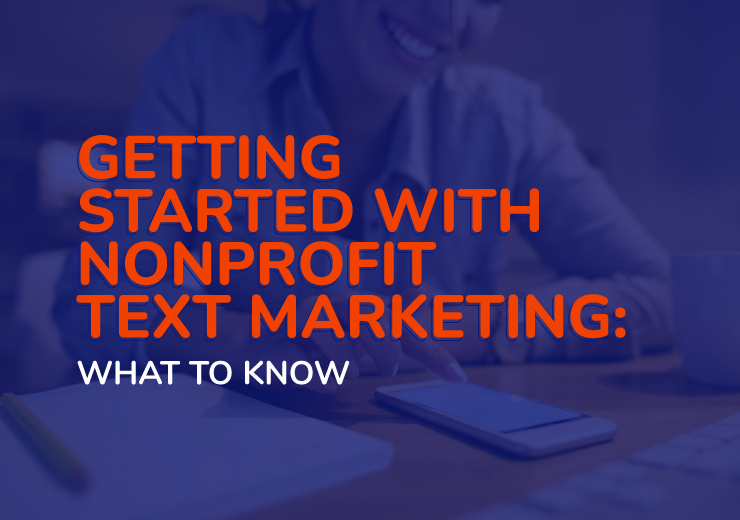Getting Started with Nonprofit Text Marketing: What to Know

From content marketing to peer-to-peer fundraising to social media ads, your nonprofit has near-endless ways to get its message out there. However, some outreach methods are more effective than others.
One standout channel for getting attention is SMS. Text messages get supporters’ attention fast, have extremely high open rates, and allow you to reach donors no matter where they are. To help your nonprofit launch a text marketing campaign that garners long-term, reliable support, this guide will walk through SMS outreach essentials.
Why Nonprofits Should Use Text Marketing
Text messaging is an increasingly popular form of nonprofit marketing, and for good reason. While you have limited space to get your point across in a text, these messages are efficient, create urgency, and help keep your nonprofit front of mind.
Plus, text messages are flexible and can be used to connect with supporters in a variety of contexts. A few use cases include:
- Fundraising. Send supporters urgent appeals, keep them informed about campaign progress, and generate excitement for time-sensitive fundraisers, like crowdfunding campaigns.
- Volunteer engagement. Volunteer management often requires fast, immediate responses. Keep your team connected by sending out texts to remind them about shifts, fill last-minute absences, and share thank you messages.
- Event promotion. When a supporter signs up for an event, text messages can help keep them informed about all relevant next steps. Send them event reminders, text QR code tickets, and follow up with messages that thank them for attending.
- Member management. If your nonprofit has a membership program, text messages are an efficient way to keep them informed about benefits, alert them to renewal opportunities, and send surveys to collect feedback.
- Program participation. Text messages aren’t just for supporters. Make your programs more accessible and encourage participation by sending your beneficiaries appointment confirmation messages, follow-up reminders, and links to resources.
Text messaging is a form of direct marketing, meaning each message is designed for that specific recipient, as opposed to an ad on social media that should be applicable to anyone who stumbles across it. This means you can use SMS to craft highly personalized messages that advance each supporter’s own personal journey with your nonprofit.
Following SMS Opt-In Requirements
While SMS has incredible reach and relationship-building potential, nonprofits can’t just add every potential supporter to their messaging lists. Text messages are subject to opt-in laws, and following these regulations is essential for respecting your supporters’ privacy and protecting your nonprofit from liability.
You can follow opt-in and out laws and create a positive user experience for your supporters by:
- Creating a clear opt-in agreement option. Whenever you provide an opportunity for supporters to join your text mailing list, use straightforward, jargon-free language that makes it clear how you’ll be messaging them and why.
- Making opting out easy. While it may seem counterintuitive, allowing supporters to easily opt out of receiving messages helps generate trust and demonstrate that your nonprofit is a respectful, professional organization. Plus, if someone is no longer interested in supporting your nonprofit, there’s no need to waste their time or yours with continued messages.
- Respecting recipients’ time. Supporters may unsubscribe if they get bombarded at odd hours with messages unrelated to their interests. Schedule messages at reasonable times when supporters are likely already looking at their phones. For example, while a “One hour left to donate before midnight!” text on Giving Tuesday might sound like a good idea, chances are that many supporters are already asleep at 11 PM.
Once someone agrees to receive text messages from your nonprofit, you can get in touch whenever and however you want. For instance, it’s perfectly legal to use phone appending to ensure the phone numbers in your supporters’ database are up-to-date. 360MatchPro’s guide to appending points out how this is especially effective for staying in touch with supporters long-term, even if they change numbers.
Using an SMS Platform
You’ll need an SMS app or provider to text supporters and analyze their engagement with your messages. Fortunately, nonprofits have a wide range of SMS messaging tools to choose from. When assessing platforms, we recommend looking for software solutions with the following features:
- CRM integrations. To keep all donor information in one place, choose an SMS tool that integrates with your CRM. For example, nonprofits using Salesforce should look for vendors that are Salesforce Partners.
- Bulk texting. Bulk messages allow you to reach your entire audience at once. However, that doesn’t mean these messages are generic or impersonal. Mogli advises using bulk texting to target specific campaigns or lists, schedule messages as a part of a campaign lifecycle, and send one-off messages.
- Automated messaging. Automation tools make every part of your text marketing strategy easier. You can create triggers to send text messages when supporters take specific actions, schedule drip campaigns, and create branching response paths to maintain engagement.
Assess your nonprofit’s marketing needs before researching SMS vendors. This will help you determine what features are must-haves and create a short list of top candidates to request demos from.
How to Launch an SMS Campaign
With your new text messaging software, it’s time to start planning your first SMS marketing campaign. Here’s a roadmap for planning out your latest outreach plan:
- Establish your goal. Text messaging campaigns can accomplish a wide range of goals, from earning donations to encouraging volunteer sign-ups. Consider what you want your first campaign to accomplish so you can create strategic text messages tailored to your audience. Plus, when you have a concrete goal, you can know for certain whether your campaign was a success.
- Build a messaging list. Create opt-in opportunities on your website and add sign-up options to your donation and volunteer registration forms. You might also ask volunteers to help expand your list by becoming fundraising ambassadors for a peer-to-peer texting campaign.
- Craft compelling messages. Segment your audience based on their interests, and create messaging templates that you can fill out with personalized details. Ensure each message has a single, clear CTA instructing supporters exactly what they should do next after reading your text.
From there, start sending your messages and monitor the results. Pay attention to what types of messages supporters click on and respond to so you can craft texts that get attention and lead to conversions.
Text marketing offers a fast, affordable way to deepen connections with your supporters. By starting small, following compliance rules, and focusing on high-value use cases, your nonprofit can use SMS to boost fundraising and engagement. Begin with one campaign and track results—you’ll be surprised by how powerful a simple message can be.


